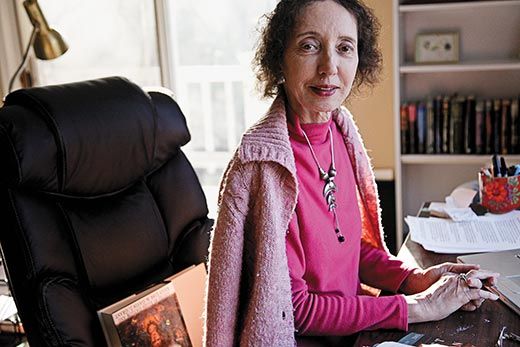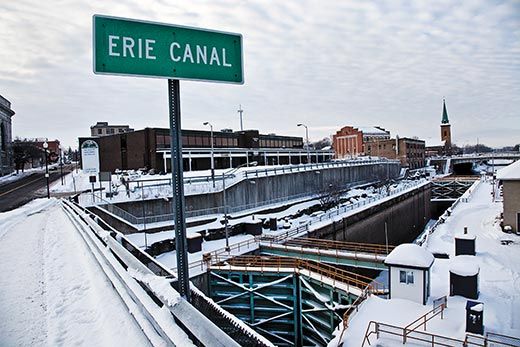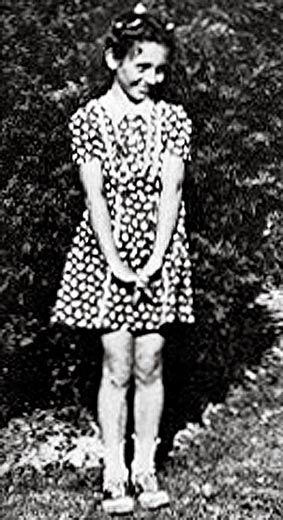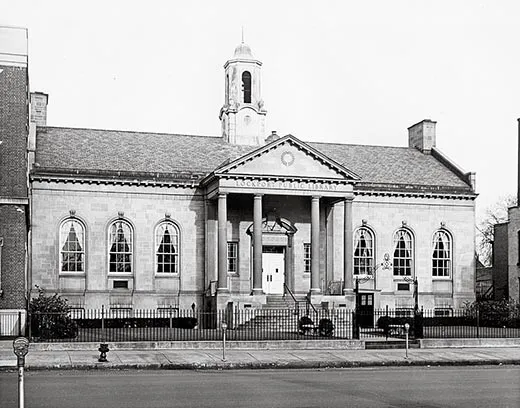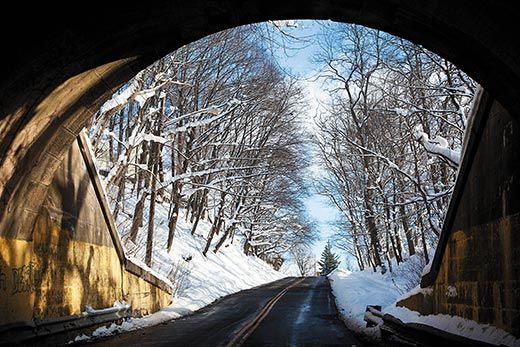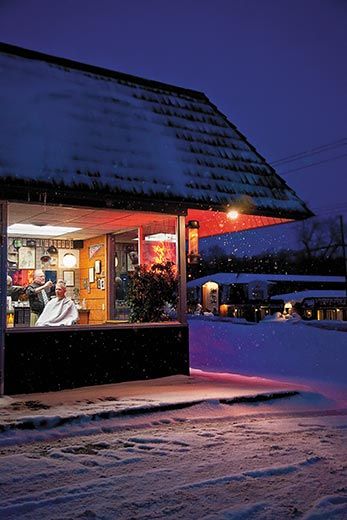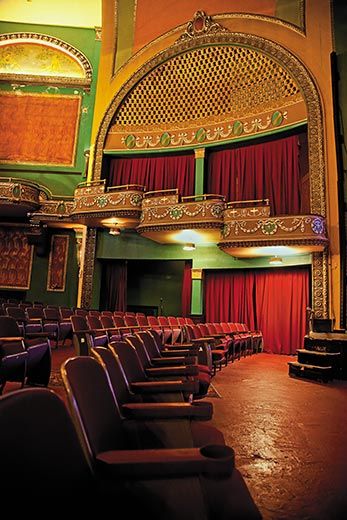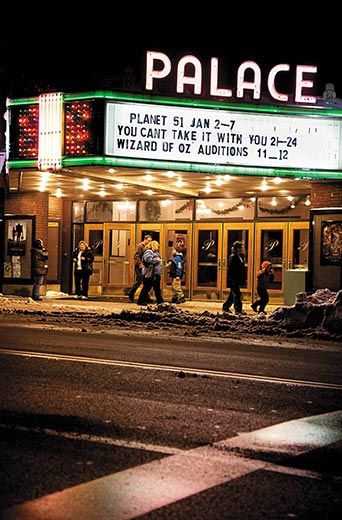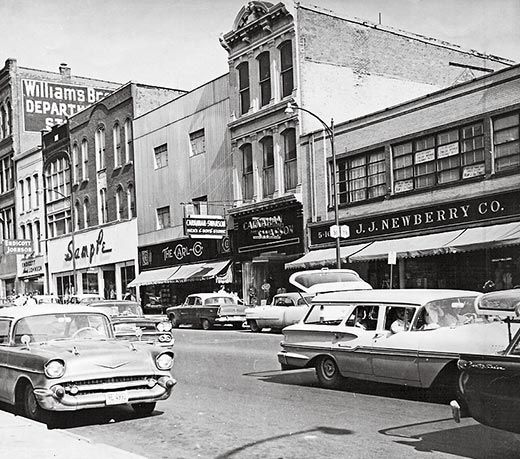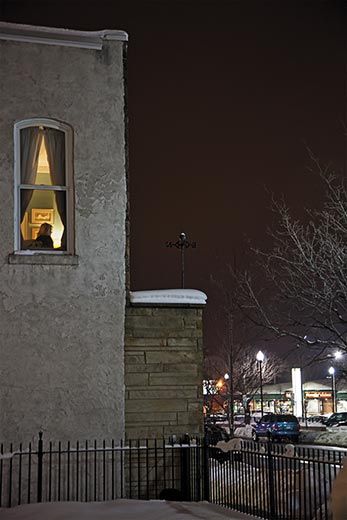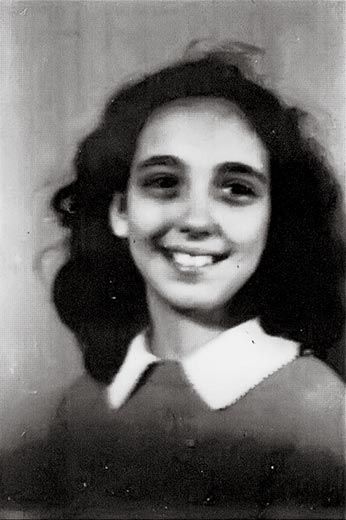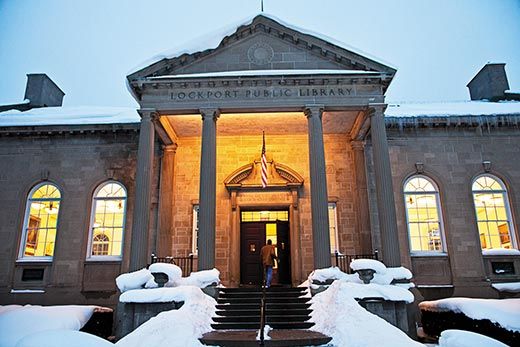Joyce Carol Oates Goes Home Again
The celebrated writer returns to the town of her birth to revisit the places that haunt her memory and her extraordinary fiction
/https://tf-cmsv2-smithsonianmag-media.s3.amazonaws.com/filer/Lockport-New-York-Erie-Canal-631.jpg)
Writers, particularly novelists, are linked to place. It’s impossible to think of Charles Dickens and not to think of Dickens’ London; impossible to think of James Joyce and not to think of Joyce’s Dublin; and so with Thomas Hardy, D. H. Lawrence, Willa Cather, William Faulkner, Eudora Welty, Flannery O’Connor—each is inextricably linked to a region, as to a language-dialect of particular sharpness, vividness, idiosyncrasy. We are all regionalists in our origins, however “universal” our themes and characters, and without our cherished hometowns and childhood landscapes to nourish us, we would be like plants set in shallow soil. Our souls must take root—almost literally.
For this reason, “home” isn’t a street address or a residence, or, in Robert Frost’s cryptic words, the place where, “when you go there, they have to let you in”—but where you find yourself in your most haunting dreams. These may be dreams of numinous beauty, or they may be nightmares—but they are the dreams most embedded in memory, thus encoded deep in the brain: the first memories to be retained and the last memories to be surrendered.
Over the years of what seems to me both a long and a swiftly passing lifetime, “home” has been, for me, several places: Lockport, New York, where I was born and went to school, and nearby Millersport, New York, my home until the age of 18; Detroit, Michigan, where I lived with my young husband Raymond Smith, 1962-68—when he taught English at Wayne State University and I taught English at the University of Detroit; and Princeton, New Jersey, where we lived for 30 years at 9 Honey Brook Drive, while Ray edited the Ontario Review and Ontario Review Press books and I taught at Princeton University, until Ray’s death in February 2008. Now I live a half-mile from that house in a new phase of my life, with my new husband, Charles Gross, a neuroscientist at Princeton University who is also a writer and photographer. The contemporary French provincial house in which we live on three acres fronting a small lake is “home” in the most immediate sense—this is the address to which our mail is delivered, and each of us hopes that this will be the last house of our lives; but if “home” is the repository of our deepest, most abiding and most poignant dreams, the landscape that haunts us recurringly, then “home” for me would be upstate New York—the rural crossroads of Millersport, on the Tonawanda Creek, and the city of Lockport on the Erie Canal.
As in a vivid and hallucinatory dream, I am being taken by my grandmother Blanche Woodside—my hand in hers—to the Lockport Public Library on East Avenue, Lockport. I am an eager child of 7 or 8 and this is in the mid-1940s. The library is a beautiful building like no other I’ve seen close up, an anomaly in this city block beside the dull red brick of the YMCA to one side and a dentist’s office to the other; across the street is Lockport High School, another older, dull-brick building. The library—which, at my young age, I could not have known was a WPA-sponsored project that transformed the city of Lockport—has something of the look of a Greek temple; not only is its architecture distinctive, with elegantly ascending steps, a portico and four columns, a facade with six large, rounded, latticed windows and, on top, a kind of spire, but the building is set back from the street behind a wrought-iron fence with a gate, amid a very green jewel-like lawn.
The library for grown-ups is upstairs, beyond a dauntingly wide and high-ceilinged doorway; the library for children is more accessible, downstairs and to the right. Inside this cheery, brightly lit space there is an inexpressible smell of floor polish, library paste, books—that particular library smell that conflates, in my memory, with the classroom smell of floor polish, chalk dust, books so deeply imprinted in my memory. For even as a young child I was a lover of books and of the spaces in which, as indeed in a sacred temple, books might safely reside.
What is most striking in the children’s library are the shelves and shelves of books—bookcases lining the walls—books with brightly colored spines—astonishing to a little girl whose family lives in a farmhouse in the country where books are almost wholly unknown. That these books are available for children—for a child like me—all these books!—leaves me dazed, dazzled.
The special surprise of this memorable day is that my grandmother has arranged for me to be given a library card, so that I can “withdraw” books from this library—though I’m not a resident of Lockport, nor even of Niagara County. Since my grandmother is a resident, some magical provision has been made to include me.
The Lockport Public Library has been an illumination in my life. In that dimension of the soul in which time is collapsed and the past is contemporaneous with the present, it still is. Growing up in a not-very-prosperous rural community lacking a common cultural or aesthetic tradition, in the aftermath of the Great Depression in which people like my family and relatives worked, worked and worked—and had little time for reading more than newspapers—I was mesmerized by books and by what might be called “the life of the mind”: the life that was not manual labor, or housework, but seemed in its specialness to transcend these activities.
As a farm girl, even when I was quite young I had my “farm chores”—but I had time also to be alone, to explore the fields, woods and creek side. And to read.
There was no greater happiness for me than to read—children’s books at first, then “young adult”—and beyond. No greater happiness than to make my way along the seemingly infinite shelves of books in the Lockport Public Library, drawing my forefinger across the spines. My grandmother was an avid reader whom all the librarians knew well, and whom they obviously liked very much; two or even three times a week she checked books out of the library—novels, biographies. I remember once asking Grandma about a book she was reading, a biography of Abraham Lincoln, and how she answered me: this was the first conversation of my life that concerned a book, and “the life of the mind”—and now, such subjects have become my life.
What we dream of, that we are.
What I most love about Lockport is its timelessness. Beyond the newer facades of Main Street—just behind the block of buildings on the northern side—is the Erie Canal: this impressive stretch of the 524-mile New York State Canal System connecting the Great Lakes with the Hudson River and traversing the breadth of the state. For residents of the area who have gone to live elsewhere, it’s the canal—so deep-set in what appears to be solid rock, you can barely see it unless you come close, to lean over the railing of the wide bridge at the foot of Cottage Steet—that resurfaces in dreams: the singular height of the falling water, the steep rock walls, the gritty, melancholy smell of stone, froth, agitated water; the spectacle of the locks opening, taking in water and closing; the ever-shifting water levels bearing boats that seem miniaturized in the slow, methodical ritual-like process. “Locksborough,” a contending name for the early 19th-century settlement, might have been a more accurate one, since there are numerous locks, to accommodate the especially steep incline of the land. (Lake Erie to the west is on a much higher elevation than the Hudson River, and Lockport—“Uptown” and “Lowertown”—is built on an escarpment.) Standing on the Big Bridge—“the widest bridge in the world,” as it was once identified—you feel a sensation of vertigo as you peer down at, or into, the canal 50 feet below; not so overwhelming as the sensation you feel staring at the legendary falls at Niagara 20 miles to the west but haunting, unnerving and uncanny. (Think of “uncanny” in the Freudian sense—Unheimlich—a sign/symptom of a deep-rooted turbulence associated with buried and unarticulated desires, wishes, fears.) In the midst of city-life, at the very noon-tide of day-life, there is the primary, primitive vein of elemental life in which human identity is vanished, as if it had never been. Falling water, turbulent water, dark frothy water churning as if it were alive—somehow, this stirs the soul, makes us uneasy on even cheery visits back home. You stare down into the canal for a long dazed minute and then turn back blinking—where?
You didn’t let Joyce see, did you? Oh—Fred!
Not a thing for a little girl to see. I hope she didn’t...
An early memory of being with Daddy—in Lockport—and there is a street blocked with traffic and people—one of the narrow streets that run parallel to the canal, on the farther side of downtown—and Daddy has stopped his car to get out and see what is happening—and I have gotten out too, to follow him—except I can’t follow him, there are too many people—I hear shouts—I don’t see what is happening—unless (somehow) I do see—for I have a vague memory of “seeing”—a blurred memory of—is it a man’s body, a corpse, being hauled out of the canal?
Joyce didn’t see. Joyce was nowhere near.
Yes, I’m sure!
Yet years later, I will write of this. I will write of a little girl seeing, or almost seeing, a man’s body hauled from a canal. I will write of the canal set deep in the earth; I will write of the turbulence of falling water, steep rock-sides, the roiling water, unease and distress and yet at the core, childlike wonderment. And I will write—repeatedly, obsessively—of the fact that adults cannot shield their children from such sights, as adults cannot shield their children from the very fact of growing up, and losing them.
So strange!—“uncanny.”
That, between the ages of 11 and 15—through sixth, seventh, eighth and ninth grades—I was a “commuter student” first at John E. Pound School on High Street, Lockport; then at North Park Junior High in the northeast section of town near Outwater Park. (Though the term “commuter student” wasn’t in anyone’s vocabulary at that time.) For five grades, I’d gone to a one-room schoolhouse in Millersport—then for no reason that was ever explained, to me at least, I was transferred to Lockport, seven miles to the north—a considerable distance for a child at the time.
In this era before school buses—at least in this rural corner of Erie County—such commuter students were required to wait out on the highway for Greyhound buses. Decades later I can recall the sudden sight—at a distance of perhaps a quarter-mile—of the large bus emerging out of nowhere, at the intersection of Millersport Highway with Transit Road, headed in the direction of my family home on Transit.
The bus! Not a greyhound, it seemed to me, but a large ungainly beast—a buffalo, or a bison.
For my predominant fear, for years, was that I would miss the bus, and miss school, prospects to be dreaded. And there was the daunting fact of the bus itself—Where would I sit each morning? With whom?—most of the other passengers were adults, and strangers.
Here began my “romance” with Lockport, which I experienced as a solitary individual mostly walking—walking and walking—along the streets of downtown, and along residential streets; over the wide windswept bridge above the canal at Cottage Street, and over the narrower bridge, at Pine Street; on paths above the towpath, winding through vacant overgrown lots in the vicinity of Niagara Street; and on the shaky pedestrian bridge that ran unnervingly close beside the railroad tracks crossing the canal. Many days, after school I went to my grandmother Woodside’s house on Harvey Avenue, and later on Grand Street, across town; after visiting Grandma, I took a city bus downtown, or walked; to this day, I have a proclivity for walking—I love to be in motion, and I am very curious about everything and everyone I see, as I’d learned to be as a young child; and so I have felt invisible also, as a child feels herself invisible, beneath the radar of adult attention, or so it seemed to me at the time. For Lockport, which I’d previously experienced only in the company of my mother, my father or my grandmother, seemed very different to me, when I was alone. The small city—26,000 residents in the 1950s, now 22,000—became an adventure, or a series of adventures, culminating with the Greyhound bus to take me back home to Millersport.
Very few girls of 11 or 12 would be allowed today to wander alone as I did, or to take a bus as I did; to be allowed, or obliged, to wait for long headache-wracked minutes—or hours—in the dreary Lockport bus station, located near Lockport’s largest employer, Harrison Radiator, a division of General Motors where my father worked as a tool and die designer for 40 years. (Why Daddy didn’t drive me into Lockport in the morning and take me home in the late afternoon, I have no idea. Was his work schedule just too different from my school schedule? There must have been some reason, but now there is no one left to ask.) What a desolate, ill-smelling place the Greyhound bus station was, especially in winter!—and winters are long, windy and bitter-cold in upstate New York; what derelict-looking individuals were to be found there, slouched in the filthy vinyl chairs waiting—or maybe not waiting—for buses. And I in their midst, a young girl with textbooks and notebook, hoping no one would speak to me, nor even look at me.
I was prone to headaches in those years. Not so severe as migraines, I think. Maybe because I strained my eyes reading, or trying to read, in that wanly lit, inhospitable waiting room, as on the jolting Greyhound bus itself.
How innocent and oblivious the 1950s seem to us now, at least so far as parental oversight of children is concerned. Where many of my Princeton friends are hyper-vigilant about their children, obsessively involved in their children’s lives—driving them everywhere, calling their cellphones, providing nannies for 16-year-olds—my parents seemingly had no concern at all that I might be endangered spending so much time alone. I don’t mean that my parents didn’t love me, or were negligent in any way, but only that in the 1950s, there was not much awareness of the dangers; it wasn’t uncommon that adolescent girls hitchhiked on roads like Transit Road—which I’d never done.
The consequence of so much unsupervised freedom was that I seem to have become precociously independent. For not only did I take the Greyhound bus into Lockport but from the bus station I walked to school; while at John E. Pound Elementary, I even walked downtown at noon, to have lunch in a restaurant on Main Street, alone. (How strange this is—wasn’t there a cafeteria in the school? Couldn’t I have brought a lunch packed by my mother, as I’d brought lunches in a “lunch pail” to the one-room schoolhouse?) Though I rarely eat in any restaurant alone as an adult, if I can avoid it, I loved these early restaurant excursions; there was a particular pleasure in looking at a menu, and ordering my own food. If any waitress thought it was peculiar that a girl so young was eating alone in a restaurant, it wasn’t brought to my attention.
Later, in junior high, somehow it happened that I was allowed to see movies alone at the Palace Theatre after school—even double features. The Palace Theatre was one of those ornate, elegantly decorated dream-palaces first built in the 1920s; there was also, across town, the less reputable Rialto where Saturday serials were shown to hordes of screaming children. Of the prominent landmarks of Lockport, the Palace Theatre resides in my memory as a place of romance; yet romance fraught with some anxiety, for often I had to run from the theater before the second feature had ended, leaving behind its baroque splendors—gilt-framed mirrors in the lobby, crimson and gold plush, chandeliers, Oriental carpets—to rush to the bus station a block or two away, to catch the 6:15 p.m. bus marked Buffalo.
In the shadowy opulence of the Palace, as in an unpredictably unfolding dream, I fell under the spell of movies, as I’d fallen under the spell of books a few years earlier. Hollywood films—“Technicolor”—coming attractions—posters in the lobby: here was enchantment! These movies of the 1950s starring Elizabeth Taylor, Robert Taylor, Ava Gardner, Clark Gable, Robert Mitchum, Burt Lancaster, Montgomery Clift, Marlon Brando, Eva Marie Saint, Cary Grant, Marilyn Monroe—inspired me to a cinematic sort of storytelling, driven by character and plot; as a writer I would strive for the fluency, suspense and heightened drama of film, its quick cuts and leaps in time. (No doubt, every writer of my generation—of all generations since the 1920s—has fallen under the spell of film, some more evidently than others.)
From time to time, solitary men “bothered” me—came to sit near me, or tried to talk to me—quickly then I would move to another seat, hoping they wouldn’t follow me. It was safest to sit near the rear of the movie house since ushers were stationed there. Once, sitting near the front, I felt an odd sensation—my foot being touched lightly—held, or pinched—as in a ghost-grip. To my astonishment I realized that a man in front of me had reached down somehow through the back of his seat to grip my foot in his fingers; I gave a little scream, and at once the man leapt to his feet and fled to an exit at the side, disappearing within seconds. An usher hurried down to ask me what was wrong and I could barely stammer an explanation, “A man—he was sitting in front of me—took hold of my foot.”
“Your foot?” The usher, a boy of 18 or 20, frowned in distaste at this prospect, as I did—my foot! In some old shoe!
As there was no comprehending anything so preposterous, so totally unnatural if not silly, the moment of crisis passed—the usher returned to his post at the rear, and I returned to watching the movie.
I don’t think that I have ever incorporated this random incident into any work of fiction of mine—it hovers in my memory as bizarre, and singular, and very Lockportian.
It is not boasted in histories of Lockport and environs that, along with such renowned past residents as William E. Miller (Republican Barry Goldwater’s vice-presidential running mate in the 1964 election, in which Democrat Lyndon Johnson was overwhelmingly elected), William G. Morgan (inventor of volleyball) and more recently Dominic “Mike” Cuzzacrea (world record-holder for marathon running while flipping a pancake), the area’s most “known” resident is Timothy McVeigh, our homegrown terrorist/mass-murderer. Like me, McVeigh grew up in the countryside beyond Lockport—in McVeigh’s case the small village of Pendleton, where his father still resides; like me, for a while, McVeigh was bused into Lockport public schools. Like me, he would have been identified as “from the country” and very likely, like me, he was made to feel, and may have exalted in feeling, marginal, invisible.
He may have felt powerless, as a boy. He may have been watchful, a fantasist. He may have told himself, Wait! Your turn will come.
In a piece I wrote for the May 8, 1995, New Yorker, on the phenomenon of McVeigh—so cruel, crude and pitiless a terrorist that he never expressed remorse or regret for the many lives he’d taken, even when he learned that some of his victims were young children and not employees of the detested “federal government”—I observed that Lockport, well into the present, suggests a more innocent time imagined by Thornton Wilder or Edward Hopper, appropriated now by movie director David Lynch: the slightly sinister, surreal yet disarmingly “normal”-seeming atmosphere of a quintessential American town trapped in a sort of spell or enchantment. That much remains unchanged over several decades—there is the Niagara Hotel on Transit Street, for instance, already seedy and disreputable in the 1950s when I had to pass by it on my way to and from school—is a consequence not of nostalgic urban planning but of economic recession. Harrison Radiator Company has been restructured and relocated, though its sprawling buildings at Walnut Street remain, mostly vacant, renamed Harrison Place. The derelict bus station has closed, replaced by a parking lot and a commercial building; Lockport High has long since vanished, moved to a newer side of town; the stately old Niagara County Bank has been reborn as a “community college.” But the Lockport Public Library remains unchanged, at least from the street—the beautiful Greek temple-facade remains, and the jewel-like green lawn; to the rear, a multimillion-dollar addition has tripled its size. Here is unexpected change in Lockport—a good change.
And there remains the canal—dug by immigrant labor, Irishmen, Poles and Germans who frequently died in the effort and were buried in the muddy banks of the canal—a waterway now placid, stately, a “tourist attraction” as it never was in its days of utility.
In America, history never dies—it’s reborn as “tourism.”
Postscript: October 16, 2009. As a guest of the Lockport Public Library inaugurating a lecture series in honor of a legendary Lockport resident, beloved teacher John Koplas, from whom my parents had taken night classes, I have returned to my hometown city—in fact, to the Palace Theatre! Instead of the 20 to 40 people I’d envisioned, there is an audience of more than 800 crowded into the now “historic” theater; on the marquee where once such names as Elizabeth Taylor, Clark Gable, Cary Grant were emblazoned is Joyce Carol Oates Oct. 16, above Hell Rell Oct. 17—a rapper from New York City.
Unlike the downscale Rialto, the Palace has been smartly renovated and refurbished, reborn as a theater that sometimes shows first-run films but more often is rented out to traveling productions, amateur local theater and one-time events like this evening’s. Before my presentation I am brought downstairs to the “green room”—a barren corridor of dressing rooms, a furnace room, closets—how unnerving this is, to find myself behind the scenes of the Palace Theatre, the temple of dreams! And in this starkly lighted setting, so antithetical to romance, to be confronting my past—as in one of those dreams in which one’s life flashes before one’s eyes—Am I really here? Here—in the Palace Theatre where long ago in the 1930s, before he’d started to work at Harrison’s, my father Frederic Oates was a sign painter, making posters for coming attractions?
On stage, I am greeted with enthusiastic applause. Perhaps I am perceived as one who has swum across a vast stretch of water, or climbed through an abyss.
Am I really here? Is this—possible?
Fifty years since I’ve left Lockport, more or less—and now for the first time I have been formally invited back to “speak”—I can’t resist telling the audience that I hope this will become a custom, and that I will be invited back again in another 50 years.
Scattered laughter, murmurings. Is “Joyce Carol Oates” being funny, or—ironic?
Gently ironic, in any case. For truly I am tremendously moved and my eyes are welling with tears, and I am particularly grateful that my brother, Fred, and my sister-in-law, Nancy, are here tonight in the audience—all that’s left of my immediate family.
My presentation is informal, improvised, laced with “gentle ironies”—in fact, it’s this very memoir of Lockport in an early handwritten draft. The audience seems appreciative, as if they are all old friends/classmates of mine—as if I am one of them and not a visitor who will depart in the morning. More than once I’m tempted to shut my eyes and in a feat of verbal legerdemain recite the names of long-ago classmates—names as deeply imprinted in my brain as the street names of Lockport—a kind of valentine-poem, a sentimental homage to the past.
At the end of my talk, amid a wave of applause—warm, welcoming, buoyant—I am presented with a framed pen-and-ink drawing of the Lockport Public Library, by gracious Marie Bindeman, the current director of the library.
How I wish that my mother, my father and my grandmother Blanche Woodside were here with me tonight—that they were alive to share this extraordinary moment. How proud we are of you, Joyce!—for pride is the lifeblood of family, recompense for hardship, endurance, loss.
Unexpected questions from the audience: “Do you think that there is a teleological purpose to the universe, and do you think that there is an afterlife?” Yet more unsettling: “Do you think that you would be the writer you are today if you’d had a middle-class or wealthy background?”
These questions, that seem to me not at all Lockportian, stop me in my tracks. Especially the second. Beyond the blinding lights, 800 people are waiting for my reply. In the exigency of the moment it seems that they really want to know, Without Millersport and Lockport—would there be “Joyce Carol Oates”?
Joyce Carol Oates’ recent novel, Little Bird of Heaven, is set in a ficticious upstate New York town that bears a strong resemblance to the Lockport of her childhood. Photographer Landon Nordeman is based in New York City.
